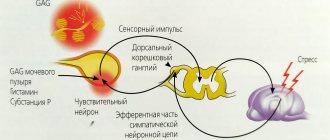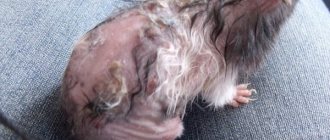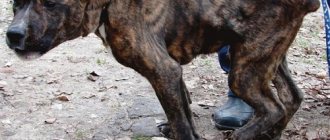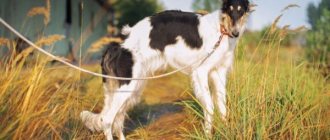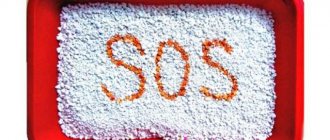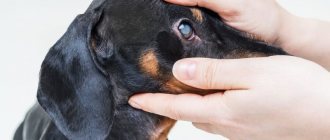5 / 5 ( 2 voices)
The disease, which many people are familiar with, also occurs among four-legged friends. Moreover, the form of manifestation is no different from human. Seeing and noticing the problem in time is the first step to quick, timely treatment.
What causes cystitis in dogs?
The main reasons that provoke inflammation of the mucous membrane of the bladder are:
- Hypothermia. Cold is tolerated differently by different breeds. Large, hardy dogs with good immunity will calmly endure a walk through puddles in the downpour. Half an hour of such pastime may be enough for a decorative dog to get sick.
Even at home you can become hypothermic, especially if you sleep on concrete or a cold floor. This is often encountered by dogs living in uninsulated enclosures.
- Diseases of the genitourinary system. Cystitis can occur as a complication. It is often provoked by urolithiasis, in which urine stagnates in the bladder. The stones themselves also damage the sensitive mucous membrane.
- Infections. The most common cause (occurs in 70% of cases). Bacteria enter the bladder in different ways: through the blood, from the kidneys, and from the urethra. Infection can occur against the background of other diseases. This form of the disease is called bacterial cystitis.
A female dog is more likely to develop cystitis than a male dog. This is explained by the structural features of the urethra: it is wider, shorter, and located closer to the anus. Also, bitches often develop cystitis during pregnancy, especially if it occurs with complications.
Causes
- entry into the urinary system from the lymph or blood of various pathogenic bacteria, viruses and fungi (Escherichia coli, strepto- and staphylococci, pasteurella, chlamydia, candida, trichomonas, etc.);
- complication of kidney diseases (urolithiasis, nephritis or pyelonephritis);
- hypothermia (the most common cause) due to the animal’s habit of sleeping in cold places and drafts, excessively long walks in cold and wet weather, owners pampering themselves with swimming in cold ponds, etc.;
- the appearance of inflammation in bitches against the background of endometritis, vaginitis, improper catheterization in violation of antiseptic rules;
- in exceptional cases – parasites (worms), an allergic reaction, taking toxic medications or tumors;
- abdominal injuries in the perineal area:
- poor quality drinking water (saturated with metal ions or harmful salts);
- problems in the blood supply to the bladder or urine flow;
- allergy to food (very rare cause).
Symptoms of the disease
It is not easy to detect the first signs, but due to the rapid development of the inflammatory process characteristic of cystitis, the animal’s condition quickly deteriorates. The main symptoms are:
- frequent urination, false urge to urinate;
- painful sensations - when urinating, the dog begins to whine;
- blood clots, pus in urine;
- painful sensations in the abdomen, the pet does not allow you to touch it;
- unpleasant specific smell of urine;
- loss of appetite, lethargy, loss of strength;
- increase in body temperature.
Signs of cystitis in a male dog can be easily determined by the position in which the dog defecates. Due to painful sensations, he cannot lift his paw as usual, he has to squat.
Cystitis or estrus how to distinguish
It is more difficult to distinguish cystitis during estrus because many of the symptoms of the disease and menstruation coincide. To diagnose the disease, it is necessary to pay attention to the presence/absence of such features, which occur only with inflammation of the bladder:
- severe pain when urinating (when the bitch is in heat, she goes to the toilet calmly);
- urine has a specific smell;
- There is a false urge to urinate.
Other signs, for example, blood clots in the urine, loss of appetite, loss of strength, increased body temperature, are present with cystitis and estrus.
Sometimes frequent urination and some other symptoms of cystitis occur as a complication in a neutered dog. They usually go away on their own and may require treatment. It is also easy to confuse cystitis after castration with complications of surgery. Therefore, animals that have undergone sterilization or castration require mandatory diagnostics so that the veterinarian can determine the signs of bladder problems.
When is cystitis suspected?
The acute form is difficult not to notice: the always clean dog suddenly begins to leave puddles in the corners or demonstratively dirty the furniture, sometimes suddenly starts whining. After the toilet, the hind legs seem to be constrained, the movements are cautious, and when trying to feel the tummy, the dog runs away or growls. The urine becomes cloudy, smells bad, and in severe cases contains mucus, strange clots, and blood. Possible rise in temperature, sluggish appetite, thirst, general depression.
In the chronic form of the disease, the pet seems healthy, but from time to time it “goes stupid.” Usually owners mistake this behavior for an attempt at dominance or hooliganism (they always tolerate it, but then suddenly it’s on the carpet!). During a walk, the girl often sits down. The male also sits down, although he usually lifts his paw. Sometimes a drop of blood can be seen at the end of the loop or penis, sometimes spots appear on the litter (pinkish or yellow).
Types of cystitis
Based on the duration of the disease, there are two types:
- Acute cystitis. Within a day after the onset of the inflammatory process, the first symptoms appear, the dog feels discomfort when urinating, and the pain syndrome rapidly increases. If left untreated, purulent cystitis occurs. This form of acute inflammation indicates the development of complications.
- Chronic cystitis. It is permanent and the animal requires maintenance therapy prescribed for life. An exacerbation is often associated with hypothermia; a dog with a chronic form of the disease needs special care. Treatment of chronic cystitis consists of preventing its exacerbation.
Based on the reasons for the appearance of the disease, there are two types:
- primary (idiopathic) cystitis – develops as an independent disease, mainly due to infection entering directly into the bladder;
- secondary - occurs against the background of other diseases, for example, when an infection enters the organs of the genitourinary system from the intestines or other internal organs.
Hemorrhagic cystitis is also isolated - a form of acute cystitis, accompanied by copious bleeding. This occurs due to injury to the vascular wall of the bladder. Allergic cystitis occurs extremely rarely in animals. Its causes may be complications from asthma, problems with the respiratory system, or various allergic reactions.
Why is it dangerous?
Cystitis is dangerous due to the development of complications, the main of which is pyelonephritis - a kidney disease accompanied by a strong inflammatory process and purulent formations. The disease causes discomfort and severe pain to the dog. The bilateral form of pyelonephritis is often fatal.
When cystitis occurs as a result of infection, the danger lies in the increased risk of spread of pathogenic microflora to neighboring organs. It often affects the kidneys and genitals. As a result, there is a need to treat several diseases at once.
Symptoms
When the first signs of cystitis appear, it is important not to delay a visit to the veterinarian. With a prolonged course of the inflammatory process, the disease becomes more complicated:
- inflammation of the prostate;
- the appearance of cystic neoplasms in the genital area;
- the development of urethritis, accompanied by impurities of pus in the urine;
- formation of stones in the urethra and bladder;
- the occurrence of enuresis (urinary incontinence), leading to renal failure;
- the development of pyelonephritis, which thins the heart muscles due to increased blood pressure (the disease is often fatal).
Due to the increased risk of secondary infection and the development of new diseases, it is necessary to start treatment at the initial stage of the disease. To do this, it is important to understand the main symptoms that occur in a sick dog.
How it manifests itself
In some cases, the disease is asymptomatic, when clear signs of cystitis do not appear. In this regard, it is important to notice the slightest changes in the character and behavior of your beloved pet.
If the animal is clean, then do not ignore the sudden appearance of puddles of urine throughout the house. It is unlikely that the always obedient dog suddenly decided to take revenge on his owners and express his dissatisfaction by ruining his favorite sofa or expensive parquet flooring.
The following symptoms will help recognize the disease:
- Changes in the color, odor and concentration of urine. The secreted liquid becomes cloudy, contains mucus, pus or a small amount of blood (in case of internal damage to the mucosa). A pungent and repulsive odor appears.
- Refusal of food. The animal loses interest in food and favorite treats.
- Changing posture when urinating. Instead of the usual raising of the hind leg, the sick male urinates while squatting.
- The appearance of pain when urinating. Any attempt to urinate causes pain for the dog, so it gets nervous and whines during and immediately after the process.
- Decreased activity. Due to constant pain, the pet tries to stop any attempts to move and shows aggression towards owners who try to move it.
- Temperature increase. A change in body temperature indicates intoxication and developing inflammation.
- The appearance of a small amount of blood at the end of the genital organs. Blood from damaged mucosa is retained on the hairs as it exits the urethra.
- Reducing the volume of urine when urinating. Inflamed tissue narrows the urinary canal, so when the animal tries to urinate, it leaves one or more drops.
- Increased frequency of urination. The narrowed channel does not allow the bladder to be completely emptied. The dog rushes all over the house, constantly asks the owner to go for a walk and leaves small puddles or drops all over the house.
- The occurrence of acute pain upon palpation of the bladder. Due to the unpleasant sensations, the animal’s abdominal muscles become very tense. The dog begins to growl and tries to run away.
The severity of the symptoms depends on the form of the disease:
- Spicy . It is accompanied by all the listed signs, so it is easy to visually diagnose. In the absence of timely treatment, the symptoms subside, and the disease becomes chronic.
- Chronic . It occurs in a sluggish form, when periodic incontinence of a sick animal is attributed to an accident. There are no behavioral changes. In some cases, the disease subsides for a short period, and each relapse occurs in an acute form.
The symptoms of cystitis resemble ICD, so self-diagnosis and taking medications are not allowed . A prolonged inflammatory process rarely responds to conservative treatment and requires surgical intervention.
Diagnostics in a veterinary clinic
In addition to identifying the disease, it is also necessary to establish its cause. For this, the following diagnostic methods are used:
- taking an anamnesis that determines possible routes of infection (improper diet, errors in maintenance, infections, allergies) or existing chronic pathologies that influenced the development of cystitis;
- general and biochemical blood and urine tests demonstrating deviations in basic parameters;
- Ultrasound, which reveals the presence of stones or sand in the urinary canal, as well as other lesions of internal organs and systems;
- X-ray showing the presence of polyps or tumors;
- urethral smear analysis to detect sexually transmitted infections;
- bacteriological analysis of urine, identifying the type of pathogenic microorganisms and their sensitivity to antibiotic treatment.
Urine test results may be distorted due to improper collection, selection of container, incorrect amount of biomaterial collected, or time and place of storage. In this regard, a sample is taken in a veterinary clinic during a direct examination of the animal. The veterinarian palpates the bladder to determine its fullness. If there is a large amount of urine, excess fluid is removed using a catheter.
The number of diagnostic methods used depends on the form of the disease:
- If the inflammation is catarrhal in nature (the infection affects only the mucous membrane of the urinary tract), then the dog is prescribed a trial treatment even before receiving the results of a urine test.
- For hemorrhagic inflammation, characterized by disruption of the vascular walls, or a chronic form of cystitis, all of the listed diagnostic methods are used.
Diagnostics
Cystitis manifests itself in a pronounced way, so at the first suspicion of the disease, you must take your pet to the clinic. Diagnostics helps the veterinarian confirm the presence of an inflammatory process in the bladder, and on its basis a treatment regimen is developed. It includes:
- urine test: first general, then additional, as prescribed by the doctor;
- smear for the presence of genital bacteria;
- Ultrasound of the kidneys.
Often the symptoms of cystitis are confused with urolithiasis, so an important part of the diagnosis is ultrasound. If there are kidney stones, they will be visible on the image, which will confirm the diagnosis of ICD; if not, inflammation of the bladder.
Types of disease
Classification by type of disease depends not only on the route of infection (ascending, descending) and the order of occurrence of the inflammatory process (primary, secondary). Depending on the cause and symptoms that appear, cystitis is divided into the following types:
- Purulent
. Accompanied by fever and acute intoxication by bacterial waste products. Along with urine, purulent clots and blood streaks come out.
- Phlegmonous
. Occurs in immunodeficiency and paracystitis (inflammation of the fiber of the ureter). It is detected during diagnosis by an excessive number of leukocytes.
- Idiopathic
. There are no obvious reasons for the violations. The disease is associated with increased levels of stress, which increases vascular permeability.
- Ulcerative
. A more dangerous variant of the purulent form, deeply affecting the muscle tissue.
- Gangrenous
. Severe inflammation, causing partial or complete tissue death.
- Serous-catarrhal
. It is characterized by severe swelling of the mucous membranes, dilation of blood vessels and detachment of the bladder epithelium. Cloudy urine contains impurities of mucus and dead leukocytes.
- Hemorrhagic
. Diagnosed together with purulent or serous-catarrhal forms. Leads to increased permeability of blood vessels and profuse hemorrhages. The urethra becomes clogged not with stones, but with blood clots.
Depending on the duration of cystitis in a dog, it can be chronic or acute. In the first case, exacerbations alternate with remissions, so the main goal of treatment is to prevent new relapses. The acute form is accompanied by poorer health and acute symptoms, but can be completely cured.
Treatment at home
In most cases, when the dog's condition is not critical, treatment at home is prescribed. Hospitalization is required only when complications have developed, so that IVs and other procedures performed under the supervision of a specialist are required.
When treating at home, it is important to provide the pet with proper living conditions. If the dog lives on the street, it must be taken into the house. The sleeping place is insulated, it is advisable to add several bedding to it. Drafts are eliminated in the room where the animal is located. Only under such conditions will the drugs used be effective.
On average, recovery takes 10-14 days, in advanced cases it takes longer. Quick treatment of cystitis is impossible; it takes time to suppress the inflammatory process.
Drug treatment
The basis of drug treatment is the use of antibiotics. Their action is complemented by antispasmodics, which eliminate pain and alleviate the dog’s condition. Veterinarians usually prescribe:
- Furadonin. The dosage is calculated based on the weight of the dog: a representative of a decorative breed weighing 1 kg will need a quarter of a tablet per day, weighing 60 kg - 4 pieces. The medicine is given along with food.
- Biseptol. The product is effective in that it fights both gram-positive and gram-negative bacteria, therefore it is universal. The whole tablet is designed for a single dose for an animal weighing 50 kg; for small dogs the dosage is calculated individually.
- Furagin. It is available in several dosage forms; injections based on it against cystitis are especially effective; the course of their use is a week. The drug has antibacterial and anti-inflammatory effects.
- Canephron. Alcohol tincture on a plant basis, intended for internal use. Dogs should be given a few drops of the drug per 1 kg of weight. The duration of treatment is 2 weeks.
- Cyston. Plant-based tablets, recommended to be taken orally after meals: 2 tablets 2-3 times a day. The drug is intended for long-term use, on average for 1-3 months, and is effective after recovery for prevention.
- Dexamethasone. A hormonal drug most often prescribed for allergic cystitis, the active ingredient is disodium phosphate. A single application is enough for 1-2 days. In addition to anti-allergic, it has a powerful anti-inflammatory effect.
You can also give your dog Nolitsin - a universal drug used to treat different animals. The duration of use is always short - no more than a week.
Medicines to combat cystitis
Painkillers and antispasmodics
- analgin: 1 tablet/20-25 kg or 0.1 ml/kg body weight intramuscularly symptomatically, can be repeated only after 10-12 hours; Contraindicated for small dogs, puppies, as well as animals with severe kidney pathology;
- no-spa (drotaverine): 1 tablet/10 kg or in a solution of 1 ml/10 kg into the muscle. It is better to give it in tablets; they inject it when it is not possible to give a tablet.
Antibiotics
- Baytril 5%: 0.2 ml/kg intramuscularly for 3-10 days. Do not mix with tetracyclines and chloramphenicol;
- cefotaxime: twice a day at the same time, 15-20 mg/kg for up to 1 week (but not less than 5 days) by intramuscular injection;
- ceftriaxone: daily dose 20-40 mg/kg, divided into 2-3 doses at equal intervals, course duration 5-10 days;
- furadonin: dose per day 5-10 mg/kg of dog weight, which should be divided into 2-4 doses per day at regular intervals. Course: up to 10 days (but not less than a week).
Solutions for catheterization
- furacillin;
- saline 0.9%;
- 0.5% protargol or tannin;
- 3% boron solution.
All liquids should be close to body temperature. It is better to rinse more often and with small portions of liquid (from 5 to 25 ml, depending on the size of the dog) than once with a large volume.
Antihistamines
- suprastin: 1 tablet/medium dog, ½ tablet/small or puppy, 1.5-2 tablets/large individual;
- allervet 1%: 2-4 rubles/day. 1 ml/5 kg of weight (or 0.2 ml/kg) subcutaneously or intramuscularly until signs of allergic manifestations of the disease disappear.
Hemostatic drugs
- dicinone: 1 ml/10 kg weight per thigh. It is important not to exceed the dosage;
- vikasol: 1-2 mg/kg into muscle, maximum 3-5 days;
- calcium chloride: a maximum of 5-15 ml is administered intravenously (slowly), depending on the size of the animal. If it gets under the skin, the area should be injected with sodium chloride to avoid necrosis.
Homeopathy and herbal preparations
They are used only in combination with the main treatment.
- Cantarene injection: inject into the thigh muscle or subcutaneously into the withers 1-3 times a day for a week to ten days or until the condition returns to normal; for chronic cystitis - once a day for up to 1 month. Dose: 0.5-4 ml/animal, depending on size;
- kantaren tablets for cystitis: the duration of treatment is determined by the veterinarian, but not longer than 1 month; 2-3 times/day for severe forms, 1-2 times/day for mild forms; single dose 1-3 tablets/animal, based on its size;
- cantharis compositum: administered by any injection method at a dose of 1-4 ml/dog repeated every 24 hours until the condition normalizes in acute cases and every 4 days in chronic cases;
- urolex: give orally 1 hour before feeding, 3 drops/kg body weight 3 times/day. Give either immediately undiluted to the root of the tongue, or dilute in a very small amount of water and pour in using a syringe. The duration of treatment should not exceed 30 days;
- cystone: 1-2 tablets per day, equal to the body weight of the animal. You can take the entire dose at once, or you can divide it into 2 doses. The full course reaches 4-6 months if the cause of cystitis is stones, and up to 2 weeks of symptomatic therapy in other cases. Taking the drug is not advisable without an appropriate diet;
- stop cystitis for dogs (see instructions below).
Herbal infusions
- pain-relieving herbs: corn silk (you can’t give it for a long time!), peppermint and lemon balm;
- have a diuretic effect: knotweed, bearberry, oregano, horsetail, St. John's wort;
- relieve inflammation: licorice, St. John's wort, oak bark, birch buds, ginger, marshmallow root, parsley.
Different herbs have different properties. Decoctions are prepared from herbs of different groups for a complex effect. Take 1 part of any herb from each name, pour in 250 ml of boiling water, infuse in a closed container for 20-30 minutes, strain and top up to 0.5 liters of the total volume. Give up to 50 ml of herbal liquid twice a day, depending on the size of the animal.
Feeding a dog during cystitis
It is important to know which foods a dog needs for cystitis and which are contraindicated, because diet plays an important role in successful recovery. It is recommended to adhere to the following rules when choosing a daily diet:
- do not give fatty, spicy, salty foods;
- exclude sausages and smoked meats;
- limit the addition of salt;
- if you use food, choose only high-quality food;
- add vegetables to your diet;
- if the characteristics of the breed allow it, give your pet cottage cheese and fermented milk products;
- introduce additional intake of vitamin complexes;
- Provide constant access to clean water.
Feeding your dog dietary foods is also important due to antibiotic treatment, which negatively affects the functioning of the digestive system.
Feeding for cystitis
The dog’s diet during the period of treatment and recovery from illness should be completely revised. The main rule for organizing nutrition during this period is to reduce the load on the pet’s urinary system.
Natural nutrition
For the entire period of treatment and recovery, you must give up meat and meat products. The diet should contain sufficient quantities of fermented milk products (ryazhenka, natural yogurt, kefir) - they will help normalize the intestinal microflora after a course of antibiotics. Be sure to drink plenty of fluids. This will help reduce the concentration of toxins in your dog's urine.
Industrial feed
Veterinary specialists switch dogs after cystitis to professional medicinal food brands.
- Hills Prescription Diet C/D is a medicinal brand for cystitis.
- Advance Veterinary Diets Urinary Canine Formula – dietary treatment.
- Hill's Prescription Diet S/D Canine Urinary-Dissolution canned – for urolithiasis.
- Farmina Vet Life Canine Struvite – for those with a tendency to form stones.
- Pro Plan Veterinary Diets Canine UR Urinary dry – for urological diseases.
- Hill's Prescription Diet U/D Canine Non-Struvite Urinary Tract Health dry is a professional therapeutic diet.
- Farmina Vet Life Canine Oxalate is a diet for animals with kidney problems and urolithiasis.
- Trovet Urinary Struvite ASD is a therapeutic diet for urolithiasis.
Prevention
Prevention includes taking the following precautions:
- adhere to the principles of proper nutrition;
- give only clean water;
- make sure that the dog does not drink water from puddles or unknown sources;
- walk your dog 2-3 times a day without skipping it;
- provide a comfortable, warm place to sleep and rest, even if the pet lives in an enclosure;
- Allow mating only with verified animals.
It is also important to have regular routine checkups with your veterinarian to ensure any problems are caught early.
Cystitis in dogs is a common disease, which is easy to cope with if its symptoms are detected in a timely manner. It occurs most often due to infection, less often due to hypothermia or concomitant diseases. The basis of therapy is antibiotics, supplemented by drugs from other groups; it is also important to follow a diet.
Drug Stop-cystitis
This is a whole series of drugs, which is represented by three herbal complex products: Stop-cystitis in tablets and suspensions and Stop-cystitis bio, also in suspension (what to give a dog for cystitis from the above is decided by a veterinarian). The drugs very quickly normalize the animal’s condition, eliminating the symptoms of the disease. The “bio” form allows you to constantly monitor the condition of the urinary system as a preventative measure. Stop-cystitis, in addition to herbal components, has medicinal components in the list of components that explain its action.
Functions of the drug: antimicrobial, antiseptic, diuretic, anti-inflammatory, saluretic (removal of sand and stones from the bladder).
Available in various volumes (maximum 150 ml). For individuals up to 10 kg, the daily dose is 4 ml, divided into 2 doses of 2 ml. If the weight exceeds 10 kg, then the daily dose increases to 6 ml, and the number of doses can be 2 or 3 (3 ml or 2 ml at a time, respectively). The duration of the course is determined by the veterinarian, paying attention to the severity of the pathology, concomitant treatment and course of the disease. For the purpose of prevention, 1 ml is given once a day for the 1st week. |
Give 1 tablet twice a day to dogs weighing up to 10 kg and 1.5 tablets if the weight exceeds 10 kg. For the purpose of prevention - once. Course 5-7 days. The tablet is placed on the base of the tongue or given simultaneously with any food convenient for administering the medicine. |
This is control and improvement of the functioning of the entire urinary system. For periodic course intake. Dosage: unless otherwise indicated by the veterinarian, then give 2 ml of the suspension to dogs weighing up to 10 kg and 3 ml if more than this weight 1-2 times a day. Duration: one week during exacerbation. And once a day, 1 ml for one month for control normalization of the condition. |
Side effects
Not noted. In very rare cases, allergic manifestations were recorded, which disappeared after stopping the drug.
Contraindications
There are no special contraindications, with the exception of individual reactions to the constituent components.
special instructions
Suspensions must be shaken before use. It is important not to miss doses - both in tablets and in suspensions, because the effectiveness of the action decreases. If a dose is missed, the next one should be taken at its scheduled time without doubling the volume.
Why is cystitis dangerous?
This disease threatens the development of pyelonephritis. As a result, the dog's body temperature increases and one-sided kidney pain occurs. Bilateral pyelonephritis is especially dangerous for the life of a pet.
The course of pyelonephritis is also dangerous because the dogs’ blood pressure increases significantly. This causes the heart to wear out faster, which is dangerous to health.
Due to cystitis, there is a high likelihood of developing urinary incontinence (enuresis). In addition, in advanced cases, chronic kidney failure occurs. The outcome of such a disease is not favorable and quite serious.
Symptoms of cystitis in dogs
Incontinence in a dog with cystitis
If you notice the following symptoms, it is important to see a doctor immediately to avoid complications. They include:
- hematuria (blood in the urine, especially at the end of urination);
- strangury (strain or discomfort when urinating);
- pollakiuria (increased urination);
- incontinence;
- discomfort (as indicated by restlessness, abdominal pain, whining, or licking);
- stiffness or reluctance to move (as some dogs develop secondary “flu-like” joint pain).
Signs of cystitis
Feeding and drinking regimen
For recovery, not only medications are important, but also proper nutrition. During treatment, the animal is prescribed a gentle diet that reduces the load on the affected organs.
When dry feeding, it is recommended to switch to a line of veterinary foods designed for pets with pathologies of the urinary system. They can be found at Hill's, Pro Plan, Royal Canin, Advance or Farmina. The packaging of medicated food must be marked C/D or S/D.
Dogs eating natural products are temporarily excluded from meat, fish and offal. An increased protein content has a detrimental effect on the kidneys, so it is replenished with natural fermented milk products (kefir, yogurt, fermented baked milk). They normalize the intestinal microflora, which is very important when taking antibiotics. The cereal used is oatmeal, which envelops and protects the walls of the stomach. All vegetables are taken boiled.
To reduce the amount of toxins and lower the concentration of urine, it is necessary to ensure adequate fluid intake. Before serving, it is filtered or boiled. In addition to water, it is recommended to give cranberry, currant or rose hip juice, which increases immunity.


